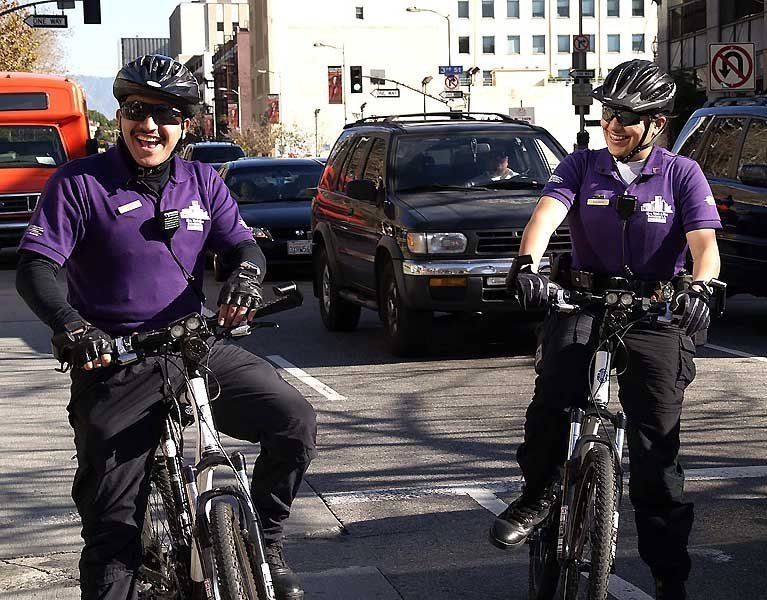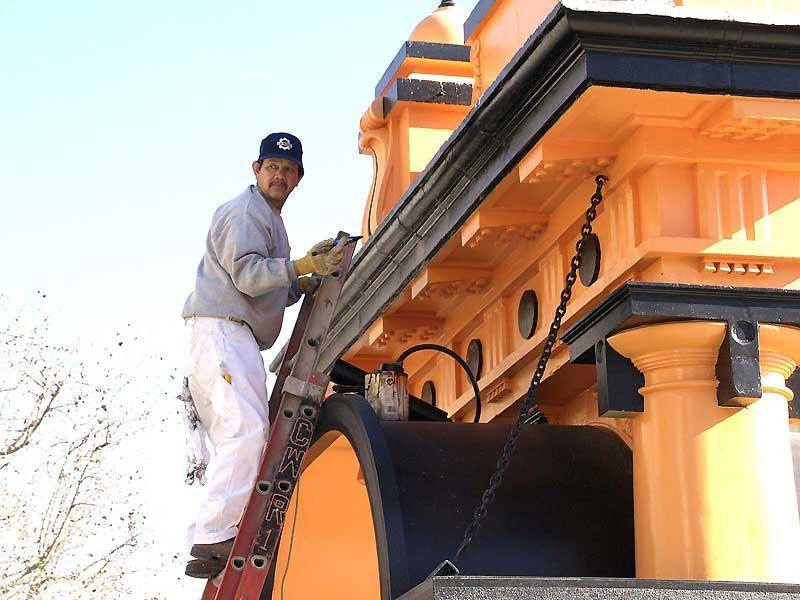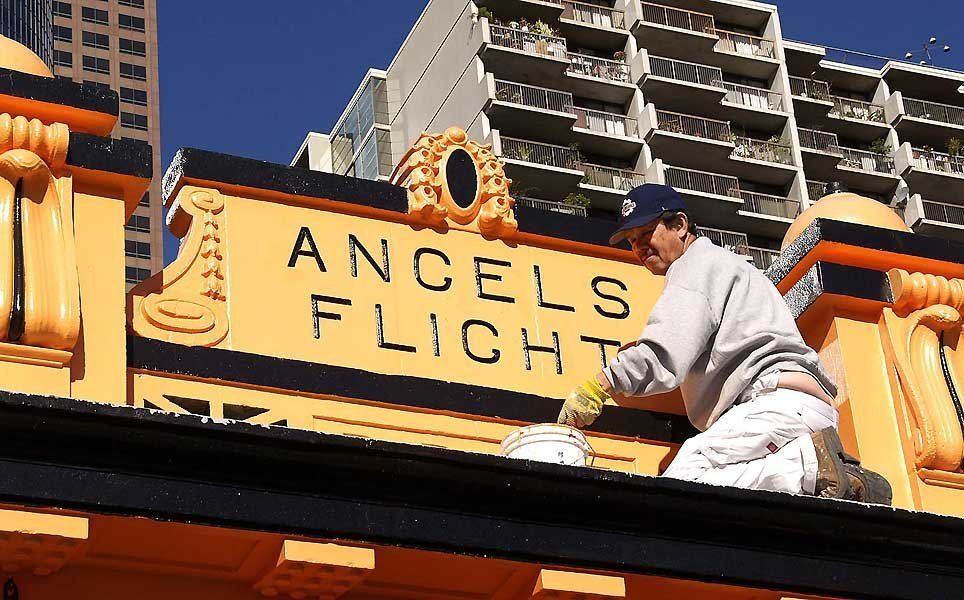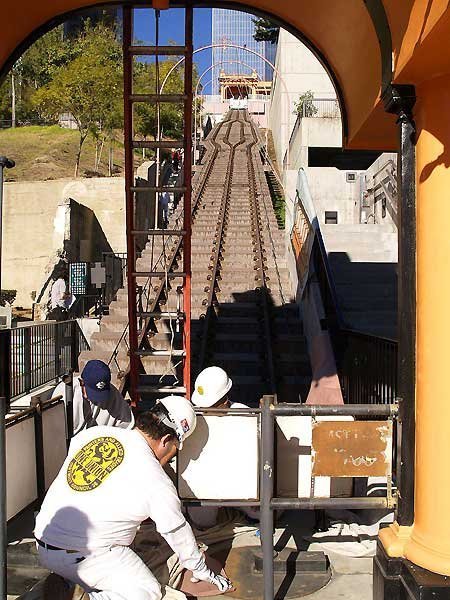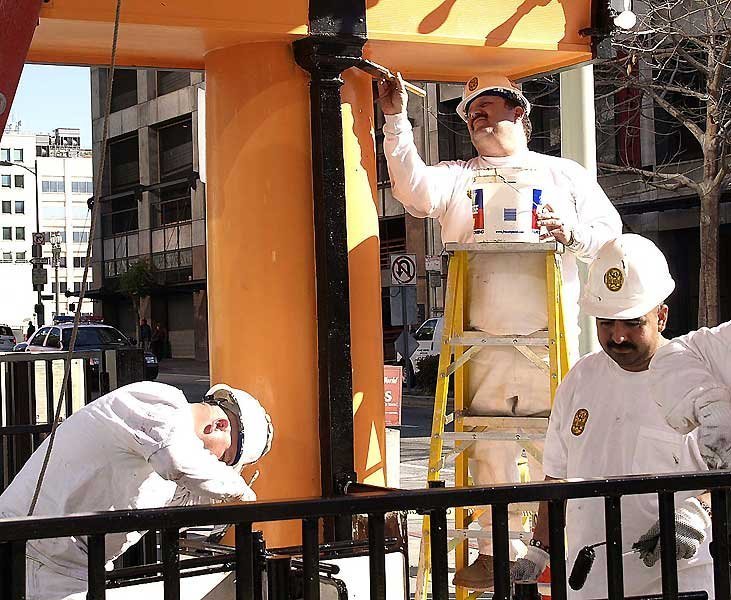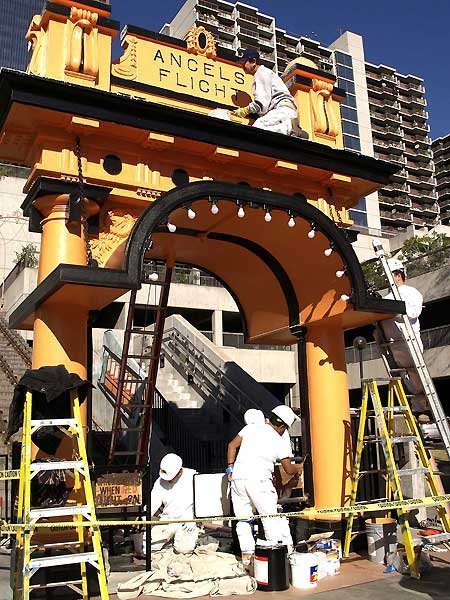Press Conference 1/23/07
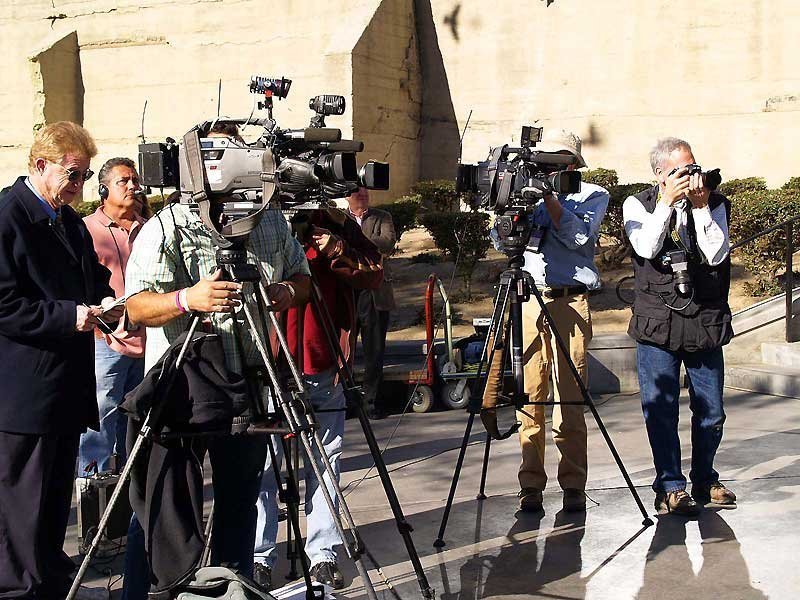
On a bright January morning in 2007, NBC, KFWB, and hordes of reporters, TV cameramen and photographers descended on the Angel Flight® Railway’s lower station — the iconic Arch on Hill Street — to hear what the President of Angels Flight® Railway Foundation would have to say.
Olivet and Sinai — the world famous twin funicular rail cars — were conspicuous by their absence, being then stored at the MTA Red Line rail yards in the “Arts District” portion of Downtown Los Angeles. The Arch was being painted a bright orange by paint crews. It was my first day on the job of documenting and archiving the history of what turned out to be the next three years, and I was excited!
~~~
~~~
FOREWORD FROM THE PHOTOGRAPHER: My father was a streetcar motorman during the days before buses came to Los Angeles. It was a time when the Pacific Electric Railway and the Los Angeles Transit Lines ruled the city tracks that spiderwebbed their way all over the Southland.
As a child, I was occasionally lucky enough to get a free ride on the streetcar with my father. We lived just two doors north of the corner of Pico and Normandie, and the P Line PC streetcars made a stop right there on the corner. I would go out into the street and stand in the painted passenger zone (that the cars knew to drive around), get on the trolleycar that my father was driving, and (if I was really lucky) get to sit right behind him as he drove the car in a huge loop from Pico and Rimpau through East L.A. and back again.
And also, during those days in the late 30s and early 40s, the wonderful Pacific Electric “Red Car” traveled up and down Hollywood Boulevard. My grandparents and uncle lived in a Hollywood hotel then, and we would take frequent trips on those lovely vehicles. I especially enjoyed them at night when the trolleywheel at the top of the trolleypole would momentarily break contact with the power line and throw off big sparks. So — all my life, I have been fascinated with streetcars: It was in the family, you might say.
And . . . while the two major electric rail companies carried the general public all over sprawling Southern California, unknown to me then was a tiny little railway — the shortest one in the world — of just two cars, that was taking a select portion of that public up and down and up and down a small hill in Downtown Los Angeles. This little railway had been doing so ever since the beginning of the 20th century, way before the advent of the Los Angeles Transit Lines or the Pacific Electric Railway. Fast forward many, many years.
When the MTA Red Line first went into service, they gave free rides all day long on opening day. My wife and I decided to have some fun and go for one of these free rides. Where we got off at the Pershing Square station, a very long escalator took us up to Fourth and Hill Streets, where we were astonished to find that Angels Flight had been moved slightly south from its original location adjacent to the Third Street tunnel. We couldn’t resist: we bought tickets and took several rides up and down the hill in Olivet and Sinai. From then on I kept looking in on Angels Flight from time to time.
We came back one day when I had acquired my first digital camera, a small Olympus point-and-shoot that packed but 1.3 megapixels (I was then a film photographer using a Minolta Maxxum 7000). So we took pictures: in, out, and around the cars, the Arch, and the Station House at the top of the hill.
Some time afterward I heard of the 2001 accident which befell Angels Flight (NTSB final conclusion: caused by the improper design and construction of the funicular drive in 1994-1995 plus failure of government safety agencies and contractors to ensure conformance to funicular safety standards). One of the two cars crashed down into the other one: of the 20 passengers aboard the two cars, eight people were hurt, with one of them subsequently dying. Angels Flight was closed, possibly forever it seemed. But then I heard some time later that preparations were being made to bring the Railway back into service — this time with a true funicular design (both cars connected to the same cable) plus cutting edge braking mechanisms as integral parts of both the Drive Assembly and the cars themselves. It was then that I got in touch with John Welborne, the president of the Angels Flight Railway® Foundation and offered my services as a photographer (by this time having long switched over to digital imaging). I told him of my history with streetcars, and he took me on.
I became — from the beginning of 2007 right through the reopening in March of 2010 — the photographer of record for the Angels Flight® Restoration Project. I took almost 2000 images documenting the needed additional repairs to Olivetand Sinai (occasioned by a careless move by MTA of the two cars from one part of the MTA Yard to another part), the installation of all-new undercarriage mechanisms to the two cars in the MTA Yard, the installation of the completely new Drive Assembly below the Station House on Bunker Hill, the trackway restoration, the laying of brand-new cables, the placing of the cars back on the tracks, the installation of highly sophisticated safety and surveillance systems, and countless other restoration tasks now documented in photographs. The cars and the Drive Assembly now have quadruple-redundancy braking, by the way.
Although I was not around for the initial, meticulously detailed post-accident repair and restoration of Olivet and Sinai in the ancient Sixth Street warehouse (now hip condos) in 2001-2002, I did follow the two cars from their subsequent long storage (and additional repairing) at the Metro Red Line rail yards, through their transport via flatbed truck and giant crane back on to their tracks (Sinai always on the north track, Olivet on the south) between the Station House by the California Plaza Watercourt on Grand Avenue and the Arch down on Hill Street. I photographed the cars’ first movements being powered by the brand-new Drive Assembly — made from scratch in Canada, built completely on modern yet tried-and-true funicular principles, shipped down to L.A. in modules and then reassembled, installed and fine-tuned under the guidance of experts from the incredible Murray-Latta Machine Company of Vancouver.
I documented the endless tweaks necessary to resolving how the cables negotiate the tracks without damage to either, and how the cars were at last made to run fully automatically by brand-new computers from start to stop at the right speeds at the simple touch of a button. I photographed the load tests wherein thousands of pounds of loaned-for-the-purpose cases of bottled water (thank you, Fiji Waters!) were put into one of the cars to simulate a carload of people — and then some. I photographed the fabrication and installation of the final government-mandated safety project: the new end-gates that the CPUC ordered added to the cars. And finally, all was ready.
With all tests passed, the CPUC gave its blessing. Angels Flight opened for business one chilly March morning in the spring of 2010 to the delight and relief of the thousands of long-stranded pedestrians (to say nothing of the owners of the adjacent businesses) who had had to negotiate the long stairway (189 steps from Hill Street to the Station House level at Grand Avenue!) so many, many times while looking wistfully at empty tracks.
To those who understand the internals of gigantic projects involving endless technical challenges and bureaucratic red tape, special thanks and appreciation for your patience! To those who were (understandably) cross and grumpy about the re-opening taking so long, we hope this site helps to explain why. Your patience (and impatience) has finally been rewarded!
Last but never least, the incomparable Bob Sutton — “Mr. Indispensable” — who was everywhere at once at all hours, day and night, constantly solving an endless array of maddening situations and challenges in totally creative ways.
I am ever grateful to John H. Welborne, the President of the Angels Flight® Railway Foundation, who so graciously allowed me in as one of the many members of “The Gang” who contributed to getting Olivet and Sinai running up and down their tracks again. He is remarkable, and the true hero of the whole restoration saga.
We hope you’ll tell your friends and fellow Angels Flight fans and rail travel enthusiasts about this very special site, and forward it to them.
And now, with a flash of the Hill Street Arch’s red warning light and a blast of its warning klaxons — to the pictures!
Leonard Auslender
Photographer, Angels Flight® Railway
Photo captions and commentary by
Leonard Auslender and John Welborne
~~~
~~~
For the camera buffs among our Angels Flight® fans, some technical information:
All photos were taken with one of two Olympus E-510 10MP cameras, one with a (FOV 2x) 36-360mm zoom lens, and another with a (FOV 2x) 140-600mm super zoom lens, both made by Zuiko. These cameras were chosen over other makes because of their exceptional light weight and portability. I never had to wrestle with awkward tripods or monopods because of 15-pound foot-and-a-half-long zoom lenses that couldn’t be handled any other way. Olympus cameras and equipment allowed me to capture the moments in a way that no other heavier camera/zooms could ever have done. (After the project was finished, I traded up and now use an Olympus E-5, keeping the E-510s for backup.)
Usual settings were ISO 800 in P mode (or manual pre-set focus where appropriate); one-step pre-sharpening; natural color. When flash (an Olympus AF-50) was used, it was set to one stop brighter than the default setting. Whenever using the flash, I first mounted the camera on a Stroboframe so I could quickly rotate the camera to vertical while still keeping the flash above the camera. At times I used a Sto-Fen diffuser to soften the harshness of the flash. Image editing was done with Photoshop, final sharpening accomplished with NikSharpen Pro, an app recommended to me by John Isaac, noted UN and National Geographic photographer.
~~~
~~~
Very special thanks go to Val d’Souza, President of PictureTrail, for his special attention and very kind personal assistance in helping our Angels Flight® Restoration Project website to operate at peak efficiency.
Dedication: I dedicate this site to the memory of my father, Archie L. Auslender: Professional streetcar motorman for the Los Angeles Transit Lines, lifelong inveterate shutterbug and darkroom denizen, who took unalloyed delight in photographing everything that passed in front of the lens of his Graflex Speed Graphic.
About the photographer: Mr. Auslender is a native Angeleno. He holds graduate and postgraduate degrees in music from UCLA and CSULA, and is a graduate of the New York Institute of Photography. In addition to being photographer for Angels Flight Railway, he is the photographer for The Affiliates of UCLA, and for the The UCLA Alumni Band. He lives with his wife Sachi in West Hollywood and has three grown children.
Legal Notice
The name “Angels Flight” and the images of the Angels Flight® Railway and cars are copyrights and registered trademarks of the Angels Flight® Railway Company and are used with permission. The content of this website, www.picturetrail.com/afrp (this “Site”), including but not limited to the text and images displayed herein and their arrangement (collectively, the “Materials”), are copyrighted © by Leonard Auslender, whether or not they bear © notices and warnings. The Materials on this Site and any other World Wide Web site owned, operated, controlled or used by Leonard Auslender for the display of any of his images and/or text may not be copied, distributed, republished, uploaded, posted or transmitted in any way without express written permission detailing specific fees and conditions of use. No permission is granted to print, copy, reproduce, distribute, transmit, upload, download, store, display in public, alter or modify the Materials, hyperlink other websites to this Site, or to use Leonard Auslender’s or the Angels Flight® Railway Company’s photographs, text, trademarks, trade names or copyrighted materials for any reason. Mr. Auslender can be reached by clicking HERE.

The Press Conference, 2/07
Television cameras, photographers, and radio reviewers all turned out to hear what John Welborne would have to say.

John Welborne and Dennis Luna
LEFT: John H. Welborne, President, Angels Flight Railway Foundation. RIGHT: Dennis R Luna, Chairman of the Board, Angels Flight Railway Foundation
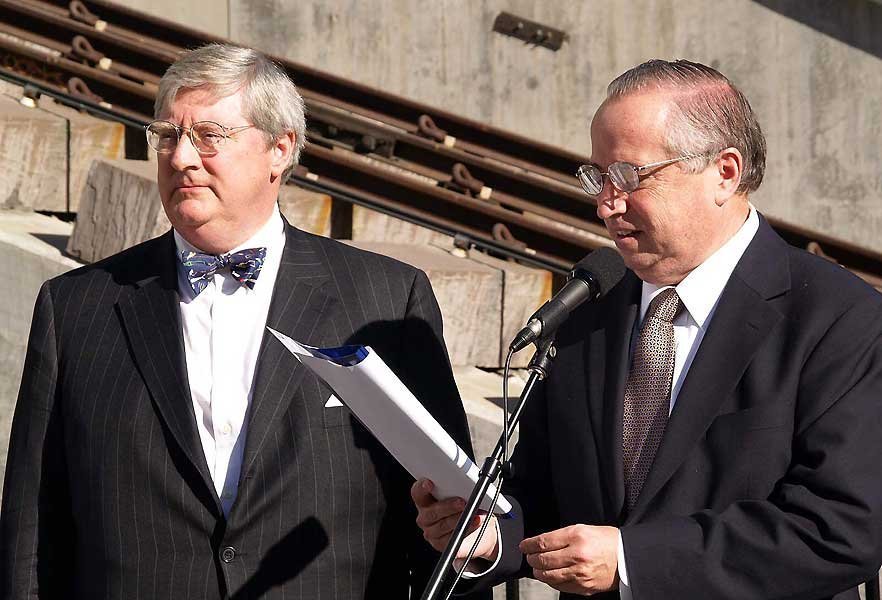
Where are the cars???
The trackway stands empty. Olivet and Sinai are a few blocks away, sitting wheel-less on special supports. They are being totally restored to full brilliance inside and outside, up, down, under, over, and sideways. It will be some time from the date of this press conference before we see them again, dramatically brought home via giant crane — which is recorded in another album.
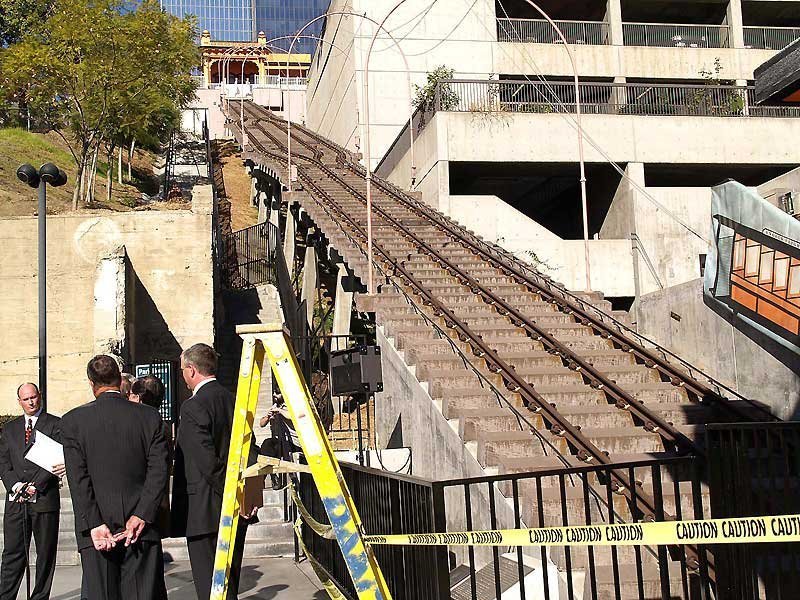
Olivet? Sinai?
On this day, this banner is as close as we could come to the real cars, which were resting on support structures in the MTA Red Line rail yards being refurbished.
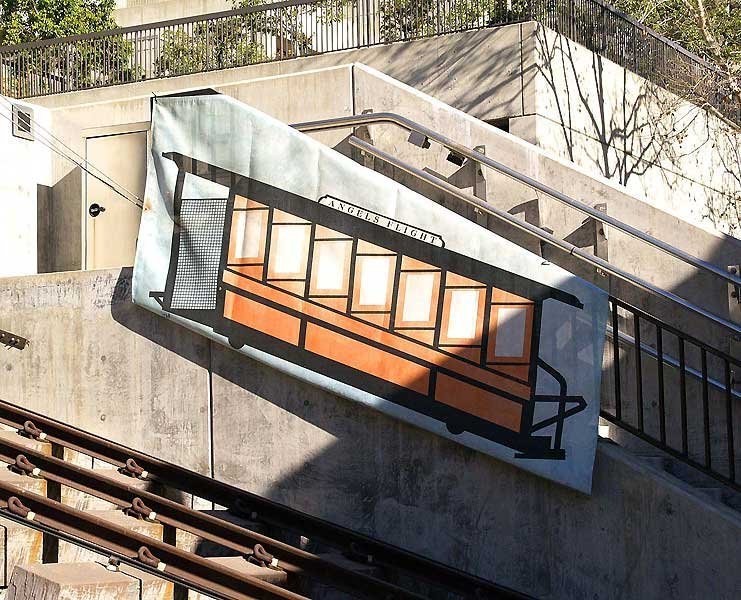
Announcements Are Made
Angels Flight supporters, left to right: Dan Piotrowski, General Manager of the Omni Hotel Los Angeles at California Plaza; Adele Yellin, of the AFRF Board and Grand Central Market; AFRF President John H. Welborne; AFRF Chairman of the Board Dennis R. Luna; George Takei, former SCRTD Board Member and Starfleet Captain; Marc B. Leh of Morrison & Foerster, Legal Counsel to AFRF; and Dickinson C. Ross, Chairman Emeritus of Johnson & Higgins of California Insurance Brokerage.
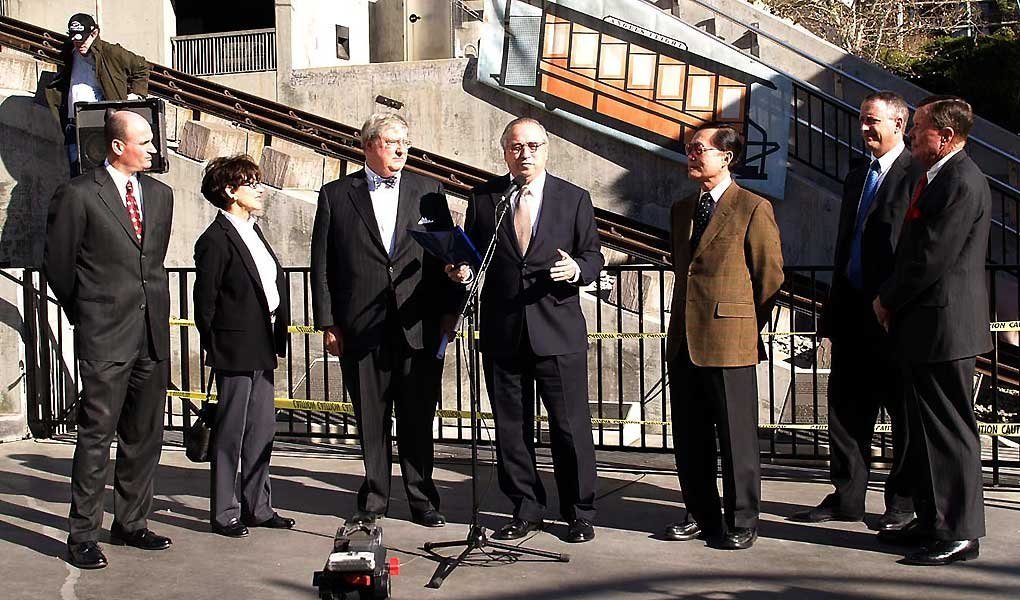
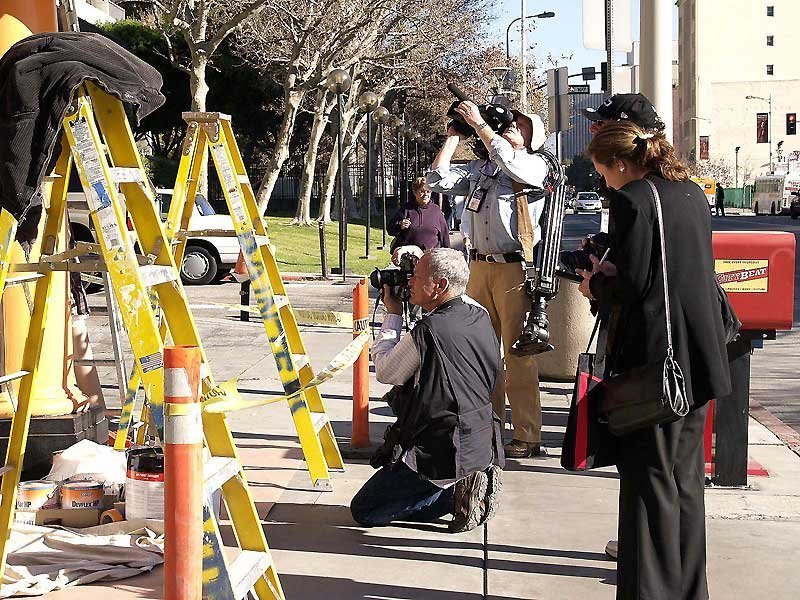
George Takei
George being interviewed by KFWB. Mr. Takei is one of the members of the Angels Flight® Railway Campaign Committee, and a staunch supporter. He revealed that while Angels Flight doesn’t actually have warp drive, it does utilize impulse power!
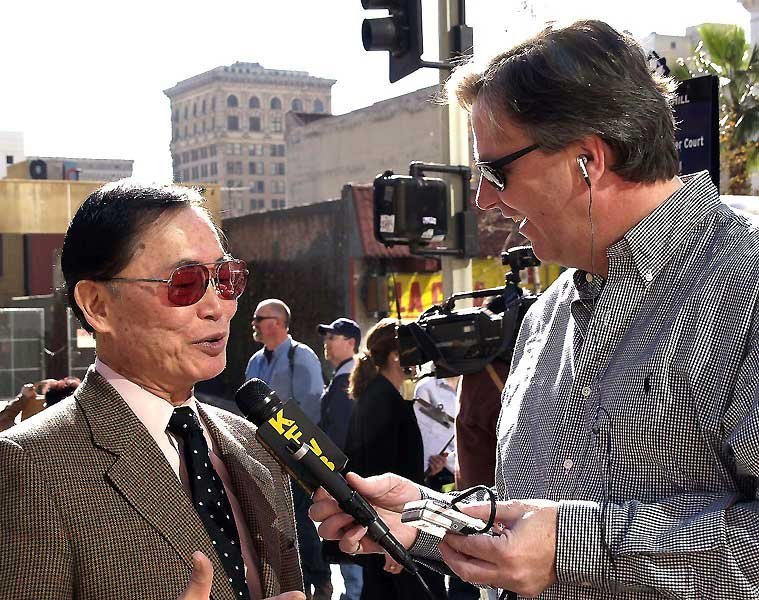
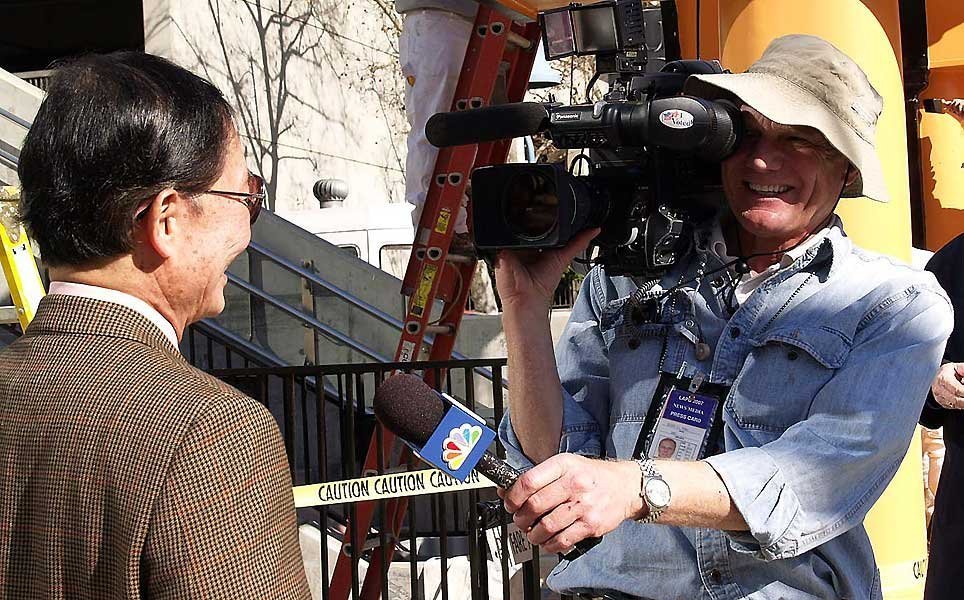
Getting the Story
John Welborne discussing things with reporters.
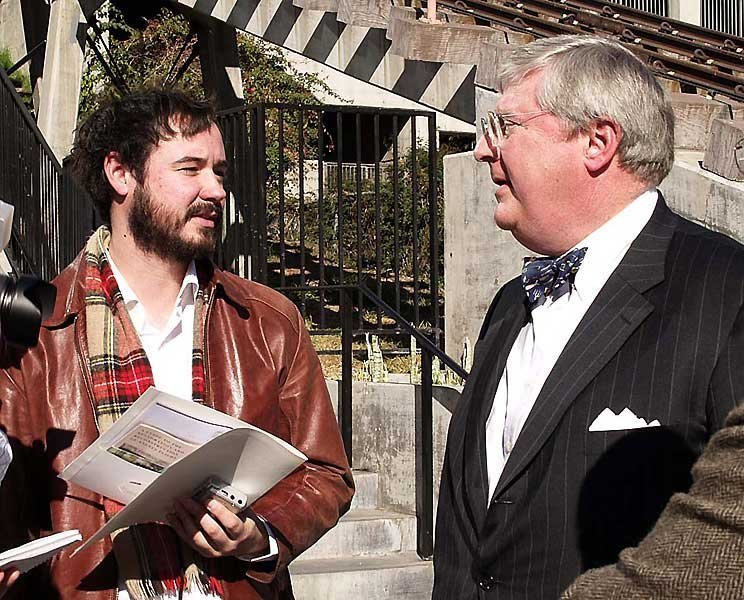
Luna & Charlebois
David D. Charlebois (right), President of California Restoration & Waterproofing, the company that restored Olivet and Sinai, chats up Dennis R. Luna, Chairman of the Board of the Angels Flight Railway Foundation.

New Paint for the Arch
Everything was getting a facelift, not just Olivet and Sinai: The Arch and The Stationhouse were getting the same bright orange with black trim treatment.
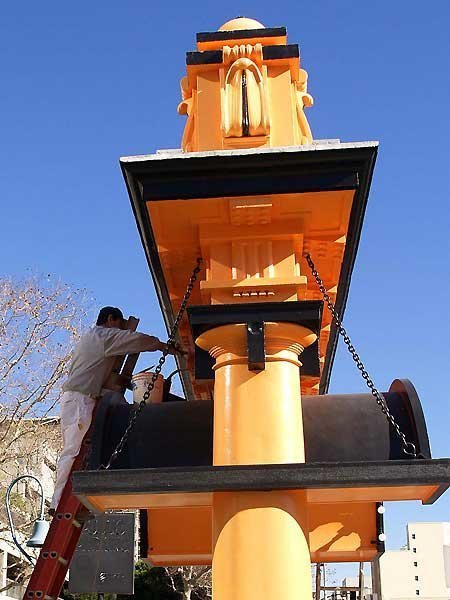
Turnstiles
Not even the turnstiles were allowed to go unspiffed! Here they got new paint, and later very sophisticated electronic equipment that counts the passengers coming through them.
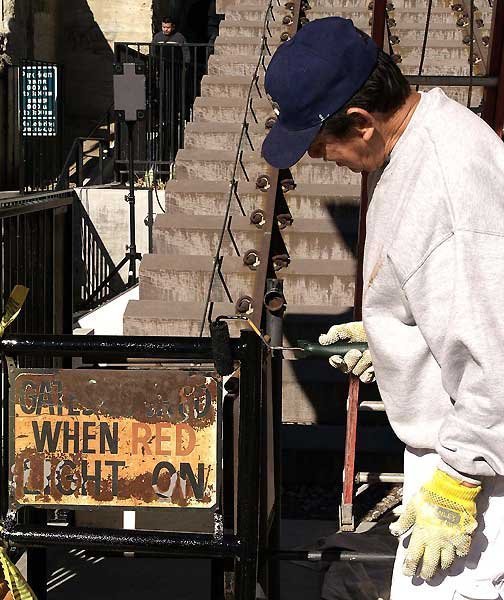
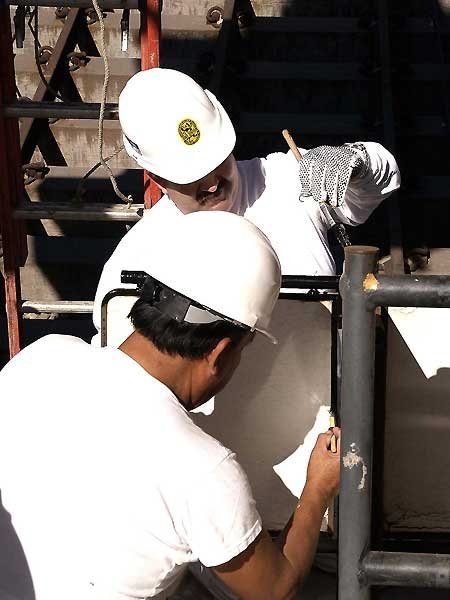
Arch
Among the stoutest supporters of Angels Flight are Mr. and Mrs. Archer, shown here with a friend standing behind them. The Archers live next door to the Railway, and Arch always is around to lend super support and appreciation! Thanks, Arch!
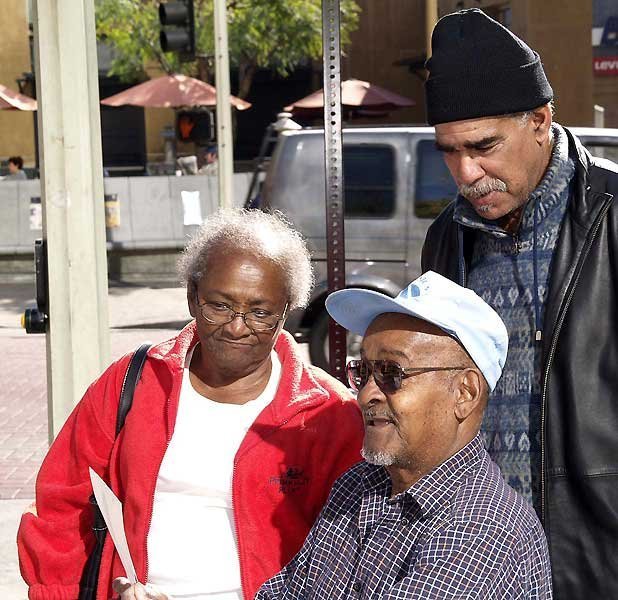
Wow!
Everybody stops by to see what’s going on!
